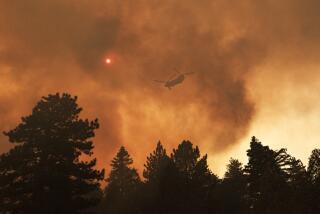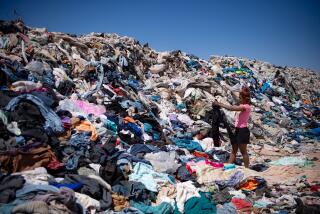Drastic Measures Needed, Scientists Say : Santiago Left Wheezing in World-Class Smog
- Share via
SANTIAGO, Chile — Scientists are calling this Andean capital one of the most polluted places on Earth and warning of the need for drastic measures to avoid an ecological catastrophe.
Respiratory diseases are becoming common among the city’s 4.5 million people, doctors say, especially among high-risk groups--the elderly, children under 5 and people with heart ailments.
Some of the causes of pollution are auto exhaust, industrial waste, dust from the city’s many unpaved streets and the mountain surroundings that provide poor ventilation.
Dr. Hernan Sandoval, a former U.N. World Heath Organization specialist who advises the Chilean government’s anti-pollution task force, said the lack of research and statistics hide the seriousness of the health threat.
‘Situation Is Alarming’
“Obviously, the high level of air pollution is affecting people’s health,” he said. “The situation is alarming. But there are no details.”
“We know we have an extremely serious contamination problem here, no doubt about that,” said Ricardo Katz, secretary of the government’s Regional Ecological Commission. “But we lack the technology to determine exactly what the problem is all about.”
He said it will take at least two years to determine how to fight pollution.
“Before that, all we can do is take emergency measures to face emergency situations, the critical moments,” Katz said.
Government Measures
In its most serious measures so far, the government this year imposed weekday driving restrictions and authorized police to seize motor vehicles that fail to meet anti-pollution standards.
The restrictions lasted most of June, July and August, the Southern Hemisphere winter months, when pollution is worst here. Vehicles with license plate numbers ending in 0 and 9 were banned on Mondays, followed on subsequent days by those ending in 1 and 8, 2 and 7, 3 and 6, and 4 and 5.
Ecologists welcomed the measure, which rotated one-fifth of the city’s 500,000 cars, trucks and buses each weekday, but they said it was not enough. Car exhaust, they said, is just one of many sources of contamination.
“We have around 1,000 kilometers (620 miles) of unpaved streets in this city, sending tons of dust into the air that we breathe,” Katz said.
University Study
A 1985 report by the University of Chile said that Santiago’s residents each year inhale 349,213 tons of carbon monoxide, 39,000 tons of hydrocarbons and 28,336 tons of sulfur oxides.
Experts say the other problem is Santiago’s poor ventilation system. The city is surrounded by mountains and has little wind in winter. During winter, the city’s inversion level--a pocket of cool air trapped near the ground by warmer air--reaches its annual low of about 900 feet. That chokes the city with its own fumes.
Jose Avendano, a consultant for the Los Angeles-based Dames and Moore Co., a consultant for Santiago officials, said that bad habits make the air worse.
These, he said, include a reluctance to switch to unleaded gasoline, poor automobile maintenance, a growing use of wood for home heating and the burning of tree leaves in autumn. And industries, offices and apartment buildings have turned from oil to cheaper coal, a more contaminating fuel, for heating systems.
Economic Slump Blamed
The rising use of coal and wood coincides with an economic slump in Chile. According to the University of Chile study, wood consumption in home fireplaces has increased 54% since 1982, while coal consumption has doubled.
The government plans to spend $4 million to measure the exact magnitude of Santiago’s pollution so it can decide how to fight it. Of that money, $2.5 million is coming from the Inter-American Development Bank and will buy monitoring equipment offered by the United States, Japan, West Germany, Israel and other countries.
Santiago’s air quality index measures only the amounts of carbon monoxide and suspended particles in the air. More often than not, the air is described as bad, something everyone knows before the daily index is announced.
Officials say that citizens are well aware of the problem. Katz said that the high rate of compliance with the driving restrictions “showed they are ready to make sacrifices to fight the problem.”
Other measures soon to be taken, he said, include the paving of streets in the city and its outskirts, revising the city’s traffic patterns and imposing new rules against industrial pollution.
More to Read
Sign up for Essential California
The most important California stories and recommendations in your inbox every morning.
You may occasionally receive promotional content from the Los Angeles Times.










